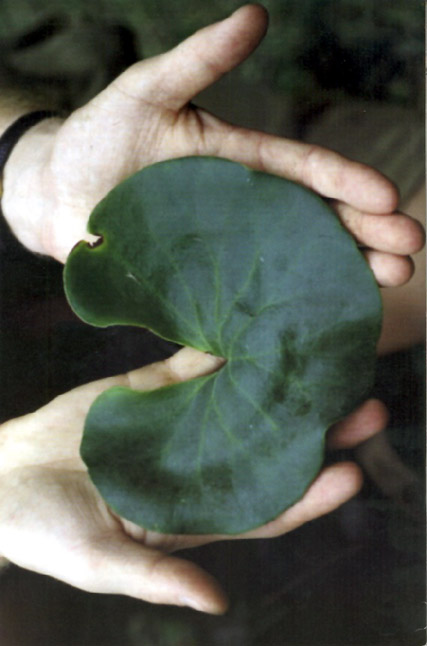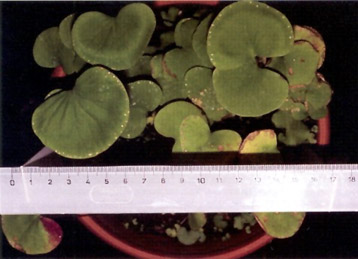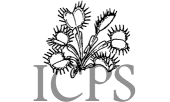Carnivorous Plant Newsletter
Volume 33, Number 2, June 2004, pages 52 - 55
New Cultivars
Drosera spatulata ‘Ruby Slippers’
Utricularia reniformis ‘Big
Sister’
Utricularia reniformis ‘Enfant
Terrible’
Drosera spatulata ‘Ruby Slippers’
Submitted: 18 March 2003
In December of 2000 I sowed and germinated some seed originally obtained earlier from the Australian Carnivorous Plant Society seed bank. It was labeled as Drosera spatulata purported to have been collected from Kowloon Peak, Hong Kong. As the plants matured, I noticed that the plants took on a dark red pigmentation and have maintained that hue ever since (see Front Cover)
The entire leaf petiole and blade exhibit dark maroon to burgundy coloration when grown in strong light, though they can exhibit more green if grown in a reduced light environment. Mature plants reach 2.5 cm in diameter when grown under strong light, but may be somewhat larger if grown in lower light levels. The underside of the leaves are covered with long (3-4 mm) white hairs, parallel to the petiole, and which are visible on the newly forming leaves before they unfurl, and on the underside of fully formed leaves. The leaves are wedge shaped, having a very short petiole in proportion to the leaf blade, very reminiscent of Drosera brevifolia, though the leaf lamina are slightly wider, the plants are overall slightly larger, and more robust in appearance.
I grow many different clones of Drosera spatulata, all under fluorescent lights in the same conditions, but specimens of Drosera ‘Ruby Slippers’ are by far the most intensely red plants. The color of Drosera spatulata from Fraser Island, Queensland, Australia is similar, but those plants are somewhat larger.
Drosera ‘Ruby Slippers’ may be propagated by seed or vegetative means, but no matter how propagated the progeny must exhibit the dark red color and the form of the standard when grown under conditions of strong light.
They are tender perennials, persisting throughout the year. Mine have been growing continuously since germinating in December of 2000.
--- William Joseph Clemens • Tucson, Arizona 85743-8872 • USA

Front Cover: Drosera spatulata ‘Ruby Slippers’. Photograph by William Joseph Clemens.
Utricularia reniformis ‘Big Sister’
Submitted: 15 March 2003
Some of the most spectacular Utricularia species are classified in the section Iperua. These plants include leafy leviathans such as U. nelumbifolia---with huge peltate leaves up to 10 cm in diameter on 45 cm long stalks---and floral goliaths such as U. humboldtii with flowers up to 10 cm across! Utricularia reniformis lives up to the high standards set by its brethren plants. Its reniform leaves are up to 14 cm in diameter, and crown petioles up to 65 cm tall (see Taylor, 1989, The Genus Utricularia---a Taxonomic Monograph, Her Majesty’s Stationery Office, London)! Its flowers are large and ornate, with blue, yellow, violet, and purple elements.
There are two types of Utricularia reniformis in cultivation. Popular with horticulturists, these two plants are clearly in need of cultivar designation; we seek to correct this deficit.
The primary distinction between the two cultivars of Utricularia reniformis is size. At maturity, Utricularia reniformis ‘Big Sister’ consistently produces large leaves i.e. at least 8 cm in diameter (see Back Cover). One of us (MS) has even observed a greenhouse specimen with leaves 22.2 cm in diameter, on a petiole 46 cm tall! Mature Utricularia reniformis ‘Big Sister’ specimens do not produce abundant small leaves (in contrast with Utricularia reniformis ‘Enfant Terrible’, described below). A second feature distinguishing the two cultivars is the incision into the leaf where the petiole attaches to the leaf blade. In Utricularia ‘Big Sister’, this cut is narrow (i.e. acute). See, for examples, the leaf lamina outlines in Taylor (1989), Figure 131 (figure elements 2,3,4). Floral characters are not considered important in distinguishing these two cultivars.
Of the two Utricularia reniformis cultivars, Utricularia reniformis ‘Big Sister’ seems to be slightly more challenging to grow well. The giant leaves are not developed to perfection if the conditions are inadequate. This plant may perhaps be treated best as an epiphyte, and should be grown in a comparatively light, airy mix. Humidity should be high.
Certainly Utricularia reniformis ‘Big Sister’ can be propagated easily by vegetative means, but plants produced by cross pollinating separate clones would be considered Utricularia reniformis ‘Big Sister’ as long as they produced the large leaves characteristic of the cultivar. Utricularia seedlings resulting from self-pollinations are sometimes nonvigorous, so we recommend the progeny of self pollinations (or even cross pollinations of plants that may be of closely related lineages) should be carefully evaluated for horticultural value. It is not known if the various clones of Utricularia reniformis ‘Big Sister’ in cultivation are genetically identical.
Additional aspects of this cultivar are discussed in the article on page 47.
---Barry Rice • Davis, California • USA
---Miloslav Studnicka • Botanic Gardens Liberec • Purkynova 1 •460 01 Liberec • Czech Republic

Back Cover: A leaf blade of Utricularia reniformis ‘Big Sister’, measuring 175 mm across, documented in Serra dos Orgaos, Brazil. Photograph by Miloslav Studnicka.
Utricularia reniformis ‘Enfant Terrible’
Submitted: 15 March 2003
Utricularia reniformis ‘Enfant Terrible’ is the smaller form of this species in cultivation. Its leaves never exceed approximately 4 cm in size, on petioles approximately 12 cm tall (see Figure 1). An interesting feature of this cultivar is the production of a carpet of minute ground-leaves under the large aerial-leaves. The diameters of these leaves range from as small as only a few mm to as large as a few cm (see Figure 2). Depending upon the cultivation conditions, Utricularia reniformis ‘Enfant Terrible’ may only have large aerial-leaves, minute ground-leaves, or both. In a relatively dry California greenhouse, one of us (BR) has observed this plant to grow only aerial leaves during the cool, amenable winter, and ground-leaves during the hotter, fierce summer.
Another feature distinguishing Utricularia reniformis ‘Enfant Terrible’ from Utricularia reniformis ‘Big Sister’ is in the nature of the leaf incision, where the petiole attaches to the leaf blade. In Utricularia reniformis ‘Enfant Terrible’, the incision is typically obtuse (instead of acute, as in Utricularia reniformis ‘Big Sister’). For examples, refer to the leaf lamina drawings in Taylor (1989), in particular Figure 131 (figure elements 5,6,7).
Utricularia reniformis ‘Enfant Terrible’ is often confused with Utricularia nephrophylla, which has 0.1-1 cm leaf blades. While the ground-leaves of Utricularia reniformis ‘Enfant Terrible’ can mimic the appearance of Utricularia nephrophylla, the larger aerial leaves of Utricularia reniformis ‘Enfant Terrible’ are diagnostic. The flowers of these two species are also quite different.
Horticulturists who possess Utricularia reniformis ‘Enfant Terrible’ are sometimes frustrated by this plant when, despite heroic cultivation measures, it does not produce gigantic leaves. This is not Utricularia reniformis ‘Big Sister’! On the other hand, Utricularia reniformis ‘Enfant Terrible’ survives easily in conditions where Utricularia reniformis ‘Big Sister’ might wither and perish.
Utricularia reniformis ‘Enfant Terrible’ is grown easily in a variety of mixes, but prefers a relatively light soil. It can be propagated vegetatively very easily. Plants propagated by sexual means should be appraised carefully regarding vigor. If they produce small aerial-leaves and the minute ground-leaves, they would be considered specimens of Utricularia reniformis ‘Enfant Terrible’.
Additional aspects of this cultivar are discussed in the article on page 47.
---Barry Rice • Davis, California • USA
---Miloslav Studnicka • Botanic Gardens Liberec • Purkynova 1 •460 01 Liberec • Czech Republic

Figure 1: Large aerial leaf blades of Utricularia reniformis ‘Enfant Terrible’, grown at the Botanic Gardens Liberec. Photograph by Miloslav Studnicka.

Figure 2: Minuscule ground-leaves of Utricularia reniformis ‘Enfant Terrible’, as they are seen below the aerial leaves. Photograph by Miloslav Studnicka.
|

